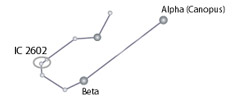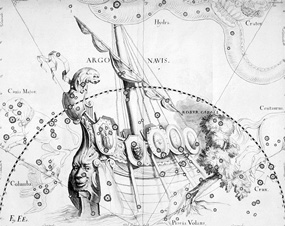Location: Mostly Southern Hemisphere, low on the horizon in the Northern Hemisphere
Coordinates:
Right Ascension: 09h
Declination: -60º
Source: Modern Constellation by astronomer Abbe Nicholas de Lacaille, from Argo Navis; Greek mythology, also Egyptian and Indian
The story behind the name: Carina means the keel or bottom of a ship. This constellation was originally part of a larger pattern representing an entire sailing ship. A ship pattern was recognized by several ancient civilizations. The Egyptians saw the constellation as the boat that carried the gods Isis and Osiris during a worldwide flood. The ancient Indians also saw a ship. The Greeks recognized a giant constellation which was called (in Latin) Argo Navis. The story most often associated with the constellation is that it represented the ship, Argo, sailed by the mythical Greek heroes Jason and the Argonauts in search of the Golden Fleece. The story of Jason was popular by the time of Homer. Jason (originally named Diomedes) was the rightful heir to the throne of Ioclan. To save his life during dynastic struggles and treachery, his mother smuggled him to Mount Pelion to be raised by the wise King of the Centaurs, Chiron. The usurper Pelias promised Jason the return of his throne if he could lift the curse placed on the kingdom. He had to find and return the ghost of Phrixas for proper burial, and bring back the Golden Fleece. Jason convinced the master builder, Argus, to construct a special ship (Argo Navis) and assembled a group of prominent Greek heros (including Heracles) for the mission. Stories of the exploits and adventures of Jason and the Argonauts became part of popular ballad cycles and Greek mythology and their ship was represented in the sky, sailing off on its exotic quest. Another explanation identifies the ship as the one that carried King Menelaus, husband of Helen of Troy, home from the Trojan Wars. The supergiant star located in the rudder of the ship, the second brightest star in the sky, is named after Canopus, the famous pilot of the fleet of Menelaus. In the 20th century, Canopus is one of the primary guide stars used to navigate spacecraft.
By the 18th century, astronomers found that Argo Navis covered too large an area of the sky to be useful in locating deep sky objects so it was deconstructed (by astronomer Nicholas de Lacaille) into three component constellations: the keel (Carina), the sail (Vela) and the poop (stern) deck (Puppis).
Introduction to Constellations | Constellation Sources | Constellations Index
Objects observed by Chandra in Carina:



